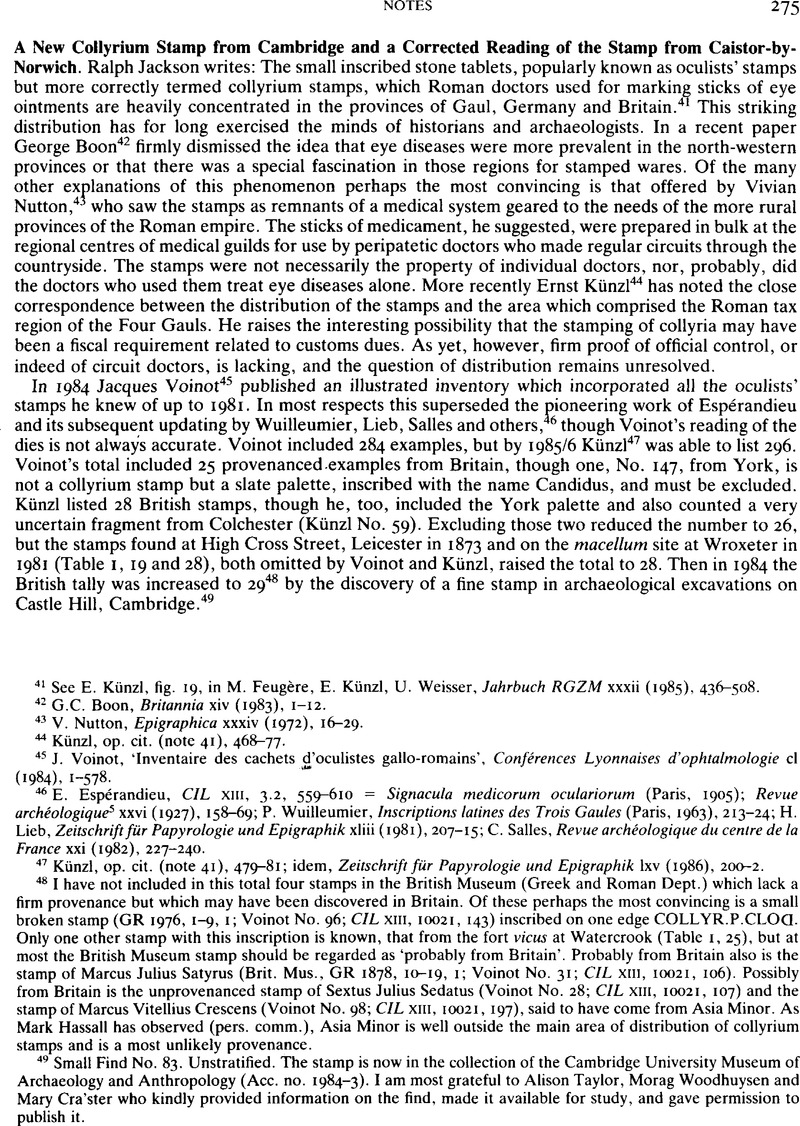Published online by Cambridge University Press: 09 November 2011

41 See E. Künzl, fig. 19, in Feugère, M., Künzl, E., Weisser, U., Jahrbuch RGZM xxxii (1985), 436–508.Google Scholar
42 Boon, G.C., Britannia xiv (1983), 1–12.CrossRefGoogle Scholar
43 Nutton, V., Epigraphica xxxiv (1972), 16–29.Google Scholar
44 Künzl, op. cit. (note 41), 468–77.
45 Voinot, J., ‘Inventaire des cachets d'oculistes gallo-romains’, Conférences Lyonnaises d'ophtalmologie cl (1984), 1–578.Google Scholar
46 E. Espérandieu, CIL XIII, 3.2, 559–610 = Signáculo medicorum oculariorum (Paris, 1905); Revue archéologique5 xxvi (1927), 158–69; Wuilleumier, P., Inscriptions latines des Trois Gaules (Paris, 1963), 213–24Google Scholar; Lieb, H., Zeitschrift für Papyrologie und Epigraphik xliii (1981), 207–15Google Scholar; Salles, C., Revue archéologique du centre de la France xxi (1982), 227–240.CrossRefGoogle Scholar
47 Künzl, op. cit. (note 41), 479–81; idem, Zeitschrift für Papyrologie und Epigraphik lxv (1986), 200–2.
48 I have not included in this total four stamps in the British Museum (Greek and Roman Dept.) which lack a firm provenance but which may have been discovered in Britain. Of these perhaps the most convincing is a small broken stamp (GR 1976, 1–9, 1; Voinot No. 96; CIL XIII, 10021, 143) inscribed on one edge COLLYR.P.CLOa. Only one other stamp with this inscription is known, that from the fort vicus at Watercrook (Table 1, 25), but at most the British Museum stamp should be regarded as ‘probably from Britain’. Probably from Britain also is the stamp of Marcus Julius Satyrus (Brit. Mus., GR 1878, 10–19, 1; Voinot No. 31; CIL XIII, 10021, 106). Possibly from Britain is the unprovenanced stamp of Sextus Julius Sedatus (Voinot No. 28; CIL XIII, 10021, 107) and the stamp of Marcus Vitellius Crescens (Voinot No. 98; CIL XIII, 10021, 197), said to have come from Asia Minor. As Mark Hassall has observed (pers. comm.), Asia Minor is well outside the main area of distribution of collyrium stamps and is a most unlikely provenance.
49 Small Find No. 83. Unstratified. The stamp is now in the collection of the Cambridge University Museum of Archaeology and Anthropology (Ace. no. 1984–3). I am most grateful to Alison Taylor, Morag Woodhuysen and Mary Cra'ster who kindly provided information on the find, made it available for study, and gave permission to publish it.
50 Contra CIL XIII, 10021, 198, where the reading of Face a is given as L VLPDECIMIN./PEN:CILLE, and contra Voinot (No. 205), who reads C VLP DECIMINI/PENICILLE, a close examination of the stamp and casts made from it reveals the following inscription: L VLPDECIMIN/PENIC AD LIP, that is, L(ucii) Vlp(ii) Decimini penic(illem) ad lip(pitudinem).
51 Ipswich, London, Mandeure, Aries, Saalburg, Jena, Naix, Mainz, Montcy St. Pierre, Trier; Voinot Nos. 248, 249, 115, 187, 224, 23, 38, 72, 203, 148.
52 De medicina I, 5, 1; II, 7, 8; VI, 6, 1.
53 Inv. No. 841. I am most grateful to Dr Alan Bowman and the Vindolanda Trust for providing details in advance of publication.
54 Voinot Nos. 5, 16, 23, 25, 31, 32, 38, 40, 62, 84, 85, 90, 97, 104, 106, no, ni, 115, 118, 175, 178, 189, 203, 204, 213, 227, 242, 254, 257, 259.
55 Voinot Nos. 23, 38, 72, 115, 148, 159, 187, 203, 211, 224, 248, 249, and 205 – see note 50, above.
56 Nielsen, H., Ancient ophthalmological agents (Odense, 1974), 83–8.Google ScholarPubMed
57 See Künzl, op. cit. (note 41), 471–4, figs. 16–17.
58 One is reminded of the Hippocratic advice, that a doctor should ‘look healthy, and as plump as nature intended him to be; for the common crowd consider those who are not of this excellent bodily condition to be unable to take care of others’. (Hippocrates, The Physician, trans. W.H.S. Jones and E.T. Withington, Loeb Classical Library, 1923–31.)
59 CIL vi, 22183(9), I0789F(2), 36746(10), 36746 (11), 4257 (2), 10558 (3), 3896(6), 3141 L(16), 2682(2), 12212(3), 25850(2), 31218 LI(55), 33116(1), 1085 i, 14195(five times), 15142. CIL Iv, Suppl. I, II 4588.
60 Celsus, De medicina VI, 6, 27. (trans. W.G. Spencer, Loeb Classical Library, 1938).
61 Nielsen, op. cit. (note 56), 80–1.
62 RIB 1618 (= CIL vII, 690); Gilson, A., Arch. Ael.5 vi (1978), 162–5.Google Scholar
63 Greek and Roman Dept. (Voinot N0. 28).
64 For information on individual stamps I am most grateful to Bob Rutland, Carolyn Wingfield, Martin Winter, Stephen Bird, Tim Strickland, Rodney Alcock, Vivien Bellamy, Michael Stokes and Arthur McGregor. I am especially grateful to Mark Hassall for bringing the Leicester stamp to my attention and to him and to George Boon for reading the paper in draft. Their comments and suggestions have improved the text in many places.
65 JRS lix (1969), 210.
66 Britannia i (1970), 282; iii (1972), 314; iv (1973), 284.
67 CBA Group 5 Arch. Newsletter 14/15 (1970); 19 (1972); 21 (1973).
68 Hughes, E.M., Ches. History xiii (1984), 13–18.Google Scholar